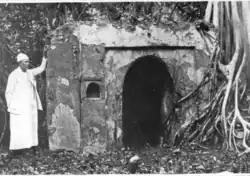Msuka Mjini Ruins
 Mosque ruins at Msuka Mjini, 1920 | |
 Shown within Tanzania | |
| Location | Micheweni District, Pemba North Region, |
|---|---|
| Coordinates | 4°54′40.32″S 39°43′40.08″E / 4.9112000°S 39.7278000°E |
| Type | Settlement |
| History | |
| Material | Coral rag |
| Founded | 15th century CE |
| Cultures | Swahili |
| Site notes | |
| Condition | Endangered |
| Ownership | Tanzanian Government |
| Management | Antiquities Division, Ministry of Natural Resources and Tourism [1] |
| Architecture | |
| Architectural styles | Swahili & Islamic |
| Official name | Msuka Mjini Ruins Historic Site |
| Type | Cultural |
Msuka Mjini Ruins (Swahili Mji wa Kale wa Msuka Mjini) is a protected historic site located inside Micheweni District of Pemba North Region in Tanzania. Msuka Mjini has a Swahili mosque from the fifteenth century preserved in ruins on the Kigomasha peninsula on the island. The date 816AH (1414 CE) is carved on the interior of the circular mirhab.[2][3][4][5]
See also
- Historic Swahili Settlements
- Archaeology of Pemba Island
- Kunduchi Ruins
- Kimbiji Ruins
- Tongoni Ruins
- Pujini Ruins
References
- ^ "Antiquities Division". Retrieved 21 Jul 2022.
- ^ "Zanzibar Historical Sites". Retrieved 25 Jul 2022.
- ^ "Settlements of Pemba and Zanzibar" (PDF). Retrieved 25 Jul 2022.
- ^ James de Vere Allen. “Swahili Culture and the Nature of East Coast Settlement.” The International Journal of African Historical Studies, vol. 14, no. 2, 1981, pp. 306–34. JSTOR, https://doi.org/10.2307/218047. Accessed 25 Jul. 2022.
- ^ Schacht, J. “An Unknown Type of Minbar and Its Historical Significance.” Ars Orientalis, vol. 2, 1957, pp. 149–73. JSTOR, http://www.jstor.org/stable/4629034. Accessed 25 Jul. 2022.